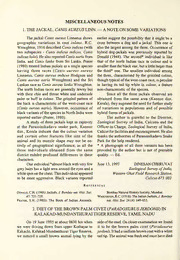
The jackal, Canis aureus Linn.: A note on some variations PDF
Preview The jackal, Canis aureus Linn.: A note on some variations
MISCELLANEOUS NOTES — THE JACKAL, CANISAUREUS LINN. A NOTE ON SOME VARIATIONS 1 . The jackal Canis aureus Linnaeus shows earlier suggest the possibility that it might be a geographic variations in coat colour. R.C. cross between a dog and a jackal. This one is Wroughton, 1916 described Canis indicus (with also the largest among the three. Occurrence of two subspecies - Canis indicus indicus, Canis hybrid dog-jackals was previously reported by indicus kola). He also reported Canis naria from Donald (1948). The second* individual is like India, and Canis lanka from Sri Lanka. Prater that of the north Indian race in colour and is (1980) treated Indian jackals as a single species smaller than the black one, but a little larger than having three races Canis aureus aureus the third* one. The smallest individual among ( Linnaeus, Canis aureus indicus Hodgson and the three, characterised by the grizzled colour, Canis aureus naria Wroughton) and the Sri though typical ofthe west-coast race, is peculiar Lankan race as Canis aureus lanka Wroughton. in having its tail tip white in colour, a feature The north Indian races are generally tawny but non-characteristic of the species. with their chin and throat white and underside Since all the three jackals observed are paler or buff in colour. The grizzled pattern of obtained from the same area (Kannur dist. the back is characteristic of the west-coast race Kerala), they augment the need for further study {Canis aureus naria). However, occurrence of of variations in populations and of possible black variants ofthe species in North India were hybrid forms ofjackals. reported earlier (Prater, 1980). The author is grateful to the Director, A study of three jackals kept in captivity Zoological Survey of India, Calcutta and the at the Parassinikadavu snake park, Kannur Officer-in-Charge, Zoological Survey of India, dist., Kerala indicate that the colour variation Calicut for facilities and encouragement. He also and certain other features like size of the thanks the authorities ofParassinikadavu Snake animal and its muzzle shape may not be en- Park for the help rendered. A tirely of geographical significance, as all the * photograph of all three variants has been three individuals obtained from the same provided—by the author but is not of printable district exhibit profound differences in these quality. Ed. characters. One individual *almostblackwithveiy few June 13, 1997 DINESAN CHERUVAT grey hairs has a light area around the eyes and a Zoological Survey ofIndia, white spot on the chest. This individual appeared Western Ghat Field Research Station, to be more aggressive. Black variants reported Calicut-673 002. References Donald, C.H. (1948): Jackals,J. Bombay nat. Hist. Soc. BombayNatural HistorySociety, Mumbai. 47: 721-729. Wroughton, R.C. (1916): The IndianJackals,J. Bombay Prater, S.H. (1980): The Book of Indian Animals. nat. Hist. Soc. 24(4): 649-653. DIET OF THE BROWN PALM CIVET (PARADOXURUSJERDONII) IN 2. KALAKAD-MUNDANTHURAI TIGER RESERVE, TAMIL NADU On 19 June 1995 at about 0630 hrs when side ofthe road. On closer examination we found we were driving down from upper Kothayar to it to be the brown palm civet (Paradoxurus Kakachi, Kalakad Mundanthurai Tiger Reserve, jerdoni). Ithadauniformbrowncoat witha white we noticed a small brown animal lying by the tail tip. The animal was fresh and must have died
